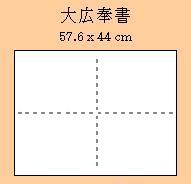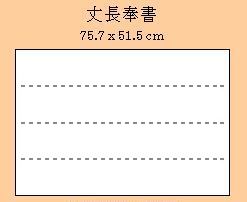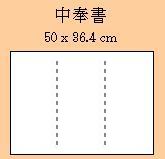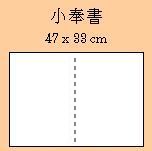Japanese Paper Dimensions (entry by David Bull)
Have you ever received a letter from a friend overseas, and noticed that something seems not quite 'right' about it? If so, it was perhaps because of the dimensions of the paper. There are a number of different standards in use around the world for paper sizes, and I am reminded of this every time I get a letter from a friend in North America; 'letter size' paper that used to look so normal to me, now looks short and fat. I have become used to the longer and 'slimmer' A4 size common here in Japan ...
In the world of printmaking too, standards for paper dimensions vary from place to place. (I had better make sure I start using the word 'dimension' rather than 'size', as that term can also take on a completely different meaning when referring to printmaking papers - 'size' is the glue-like substance brushed on to strengthen them.) Japan has a long history of papermaking, so of course dimensions of traditional paper here have been fixed for centuries.
If you flip through a book that illustrates old
Japanese prints, you may think at first that there is no rhyme or
reason to the shapes and sizes dimensions you see,
but there is actually a very logical pattern behind them.
I have in front of me here a textbook with a breakdown of traditional paper dimensions, and I'll list some of that information in this entry. I will spare you from the traditional Japanese measurements ... the 'shaku' and 'sun' ..., and will list everything in metric units. For those Americans who may balk at this, I'm sorry, but I don't have too much sympathy. I was born in England, leaving there when I weighed just about 2 1/2 stone, and then lived for many years in Canada, where I gained a number of pounds. Now I live in Japan, weigh 65 kilograms, and order my woodblocks in 'shaku' ...
'Hosho' printmaking papers ...
Early Japanese prints were made on a number of different types of paper, but once the full-colour work came into being (in the mid-1700's) prints were almost exclusively made on the famous 'hosho' paper. Most of this paper came from the Echizen district (the modern prefecture of Fukui) and was generally known as Echizen Hosho, a term still in use today. Many of the present paper-makers can trace their family roots back directly to those times.
The most common dimension for this paper is the O-bosho ('large hosho') - at 39.4 x 53cm.

When cut vertically down the middle, this sheet supplied the material for two of the 'O-ban' ukiyo-e prints, the most common size. Think of an Utamaro beauty (vertical format), or a Hiroshige landscape (horizontal) ... this is the paper that was used to make them.
When cut vertically into three strips, instead of two, we have the paper that was used for such works as those famous Hiroshige 'Birds and Flower' prints.
In the 'old days' prints were nearly always trimmed clean on all four sides very close to the image area, and very little margin of surrounding paper was left. In this century, as it became more common for prints to be matted and framed, the papermakers were pressed to increase the dimensions slightly to allow for these extra margins. Modern O-bosho is thus generally larger than the above mentioned traditional size, and to complicate matters somewhat, each family has their own definitions. I have here sheets from Mr. Kazuo Yamaguchi at 41 x 57cm, and from Mr. Iwano Ichibei at 45 x 55cm, and both these men describe the paper as O-bosho.
Going up in size from O-bosho, we have another common paper, the O-biro-bosho ('large, wide hosho') - at 44 x 57.6cm.

The most common use for this paper was in the making of the famous Harunobu prints, the paper being quartered to produce the size known as 'chu-ban'.
And again, some modern makers are producing these sheets in a larger size: where Mr. Yamaguchi has stayed with a traditional 44 x 57, Mr. Iwano's is 48.5 x 60.5cm.
Going still larger, we have the Takenaga-bosho at 51.5 x 75.7cm.

Imagine this sheet split into four strips (horizontally), and you have the paper that was used to make the 'hashira-e' prints, those tall narrow designs meant to decorate the vertical pillars of the old Japanese houses. Mr. Iwano's equivalent of this paper is at 56 x 80cm.
Going down in dimension from the standard O-bosho we have the Naka-bosho ('chu-bosho', or 'middle hosho') and the Ko-bosho ('sho-bosho', or 'small hosho').


Neither of the makers I have been dealing with list these papers on their standard price lists, although they would of course make them on order. The smaller the sheets become, the less economical it is for them to make them - pretty much the same time and labour is required as for the larger sheets, but the price must of course be less ...
The naka-bosho was commonly split into three strips vertically, and many of the famous actor prints by Shunsho were made on this paper. The ko-bosho, when divided into two, provided the material for such prints as Sharaku's actors series.
Some other types of paper in common use for traditional Japanese printmaking are 'mino', 'hosokawa' and 'hodomura'. Originally, they were made with a dimension of 33 x 85cm, a wide sheet that could be cut up in many different ways. Modern makers now make such paper in a double frame, usually about 61 x 86cm., and this dimension has now come to be known as 'Mino-ban' or 'Hodomura-ban', whatever the type of paper.
Confused? Perhaps all this doesn't really matter. Casual users of Japanese paper just make do taking whatever they get from their paper store, while 'heavy' users order directly from the maker in whatever dimension they want.
But if you keep these standard dimensions in mind when planning your print designs, you can save yourself a lot of wasteful trimming.